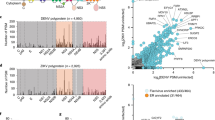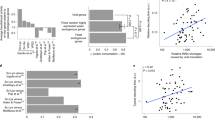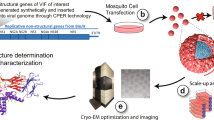Abstract
The geographical distribution of schizophrenia was previously shown to correlate with the global distribution of tick-borne flaviviruses. The correlation suggests a natural resistance gene to flaviviruses could be involved in schizophrenia. The flavivirus resistance gene, Flv, a gene found in wild mice and certain in-bred strains, confers resistance to flaviviruses through the interaction of cellular proteins with the flaviviral 3′ untranslated regions (UTRs). Although the sequence and product of Flv are unknown, translation elongation factor α-1 (EF-1) is a protein known to interact with the 3′ UTR flavivirus RNA, forming some complexes with long half-lives that inhibit RNA growth. A study was performed to assess the homology between flaviviral UTRs, subunits of EF-1, and selected proteins reported as abnormal in schizophrenia. The UTRs of four flaviviruses with wide geographical and phylogenic distribution were manually translated. Using the National Biomedical Research Foundation protein databank, the amino acid sequences were correlated with the amino acid sequences of selected proteins. The amino acid sequences of the EF-1 subunits were then correlated with the same proteins. Similar amino acid correlations between the proteins, EF-1 subunits and viral UTRs suggest that translational pathophysiology resulting from the product of Flv can be postulated as the cause of protein abnormalities observed in schizophrenia.
This is a preview of subscription content, access via your institution
Access options
Subscribe to this journal
Receive 12 print issues and online access
$259.00 per year
only $21.58 per issue
Buy this article
- Purchase on Springer Link
- Instant access to full article PDF
Prices may be subject to local taxes which are calculated during checkout
Similar content being viewed by others
References
Brown JS Jr . Geographic correlation of multiple sclerosis with tick-borne diseases Mult Scler 1996 1: 257–261
Dorst J . The Migration of Birds Ch 7, Sea-bird migration Houghton Mifflin: Boston 1962 pp?171–206
Nicholls TH, Callister SM . Lyme disease spirochetes in ticks collected from birds in midwestern United States J Med Entomol 1996 33: 379–384
Olsen B, Duffy DC, Jaenson TG, Gylfe A, Bonnedahl J, Bergstrom S . Transhemispheric exchange of Lyme disease spirochetes by seabirds J Clin Microbiol 1995 33: 3270–3274
Lanciotti RS, Roehrig JT, Deubel V, Smith J, Parker M, Steele K et al. Origin of the West Nile virus responsible for an outbreak of encephalitis in the northeastern United States Science 1999 286: 2333–2337
Brown JS Jr . Geographic correlation of schizophrenia to ticks and tick-borne encephalitis Schizophr Bull 1994 20: 755–775
Rubinstein G . Schizophrenia, rheumatoid arthritis and natural resistance genes Schizophr Res 1997 25: 177–181
Weis JJ, McCracken BA, Ma Y, Fairbairn D, Roper RJ, Morrison TB et al. Identification of quantitative trait loci governing arthritis severity and humoral responses in the murine model of Lyme disease J Immunol 1999 162: 948–956
Pulver AE . Search for schizophrenia susceptibility genes Biol Psychiatry 2000 47: 221–230
Berrettini WH . Genetics of psychiatric disease Annu Rev Med 2000 51: 465–479
Shellam GR, Sangster MY, Urosevic N . Genetic control of host resistance to flavivirus infection in animals Rev Sci Tech 1998 17: 231–248
Webster LT . Inheritance of resistance of mice to enteric bacterial and neurotropic virus infections J Exp Med 1937 65: 261–286
Sabin AB . Nature of inherited resistance to viruses affecting the nervous system Proc Natl Acad Sci USA 1952 38: 540–546
Kozak CA, Stephenson DA . Mouse chromosome 5 Mamm Genome 1998 8: S91–S113
Sangster MY, Urosevic N, Mansfield JP, Mackenzie JS, Shellam GR . Mapping the Flv locus controlling resistance to flaviviruses on mouse chromosome 5 J Virol 1994 68: 448–452
Urosevic N, Mansfield JP, Mackenzie JS, Shellam GR . Low resolution mapping around the flavivirus resistance locus (Flv) on mouse chromosome 5 Mamm Genome 1995 6: 454–458
Urosevic N, Silvia OJ, Sangster MY, Mansfield JP, Hodgetts SI, Shellam GR . Development and characterization of new flavivirus-resistant mouse strains bearing Flvr-like and Flvmr alleles from wild or wild-derived mice J Gen Virol 1999 80: 897–906
Sangster MY, Mackenzie JS, Shellam GR . Genetically determined resistance to flavivirus infection in wild Mus musculus domesticus and other taxonomic groups in the genus Mus Arch Virol 1998 143: 697–715
White DO, Fenner FJ . Medical Virology 4th edn, Ch 26, Flaviviridae Academic Press: San Diego pp?433–450
Brinton MA, Fernandez AV, Dispoto JH . The 3′-nucleotides of flavivirus genomic RNA form a conserved secondary structure Virology 1986 153: 113–121
Proutski V, Gould EA, Holmes EC . Secondary structure of the 3′ untranslated region of flaviviruses: similarities and differences Nucleic Acids Res 1997 25: 1194–1202
Proutski V, Gaunt MW, Gould EA, Holmes EC . Secondary structure of the 3′-untranslated region of yellow fever virus: implications for virulence, attenuation and vaccine development J Gen Virol 1997 78: 1543–1549
Shi P-Y, Brinton MA, Veal JM, Zhong YY, Wilson WD . Evidence for the existence of a pseudoknot structure at the 3′ terminus of the flavivirus genomic RNA Biochemistry 1996 35: 4222–4230
Wengler G, Castle E . Analysis of structural properties which possibly are characteristic for the 3′-terminal sequence of the genome RNA of flaviviruses J Gen Virol 1986 67: 1183–1188
Rice CM, Lenches EM, Eddy SR, Shin SJ, Sheets RL, Strauss JH . Nucleotide sequence of yellow fever virus: implications for flavivirus gene expression and evolution Science 1985 229: 726–733
Shi P-Y, Li W, Brinton MA . Cell proteins bind specifically to West Nile virus minus-strand 3′ stem-loop RNA J Virol 1996 70: 6278–6287
Blackwell JL, Brinton MA . Translation elongation factor-1 alpha interacts with the 3′ stem-loop region of West Nile virus genomic RNA J Virol 1997 71: 6433–6444
Negrutskii BS, Elskaya AV . Eukaryotic translation elongation factor 1α: structure, expression, functions, and possible role in aminoacyl-tRNA channeling Prog Nucleic Acid Res 1998 60: 47–78
Schmauss C . Enhanced cleavage of an atypical intron of dopamine D3-receptor pre-mRNA in chronic schizophrenia J Neurosci 1996 16: 7902–7909
Impagnatiello F, Guidotti AR, Pesold C, Dwivedi Y, Caruncho H, Pisu MG et al. A decrease of reelin expression as a putative vulnerability factor in schizophrenia Proc Natl Acad Sci USA 1998 95: 15718–15723
Huntsman MM, Tran BV, Potkin SG, Bunney WE Jr, Jones EG . Altered ratios of alternatively spliced long and short gamma2 subunit mRNAs of the gamma-amino butyrate type A receptor in prefrontal cortex of schizophrenics Proc Natl Acad Sci USA 1998 95: 15066–15071
Weinberger DR . Cell biology of the hippocampal formation in schizophrenia Biol Psychiatry 1999 45: 395–402
Gattaz WF, Lara DR, Ilkis H, Portela LV, Goncalves CA, Tort AB et al. Decreased S100-beta protein in schizophrenia: preliminary evidence Schizophr Res 2000 43: 91–95
Karson CN, Mrak RE, Schluterman KO, Sturner WQ, Sheng JG, Griffin WS . Alterations in synaptic proteins and their encoding mRNAs in prefrontal cortex in schizophrenia: a possible neurochemical basis for ‘hypofrontality’ Mol Psychiatry 1999 4: 39–45
Vawter MP, Howard AL, Hyde TM, Kleinman JE, Freed WJ . Alterations of hippocampal secreted N-CAM in bipolar disorder and synaptophysin in schizophrenia Mol Psychiatry 1999 4: 467–475
Eastwood SL, Harrison PJ . Detection and quantification of hippocampal synaptophysin messenger RNA in schizophrenia using autoclaved, formalin-fixed, paraffin wax-embedded sections Neuroscience 1999 93: 99–106
Davidsson P, Gottfries J, Bogdanovic N, Ekman R, Karlsson I, Gottfries CG et al. The synaptic-vesicle-specific proteins rab3a and synaptophysin are reduced in thalamus and related cortical brain regions in schizophrenic brains Schizophr Res 1999 40: 23–29
Sokolov BP, Tcherepanov AA, Haroutunian V, Davis KL . Levels of mRNAs encoding synaptic vesicle and synaptic plasma membrane proteins in the temporal cortex of elderly schizophrenic patients Biol Psychiatry 2000 48: 184–196
Eastwood SL, Harrison PJ . Hippocampal synaptic pathology in schizophrenia, bipolar disorder and major depression: a study of complexin mRNAs Mol Psychiatry 2000 5: 425–432
Jonston-Wilson NL, Sims CD, Hofmann JP, Anderson L, Shore AD, Torrey EF et al. Disease-specific alterations in frontal cortex brain proteins in schizophrenia, bipolar disorder, and major depressive disorder. The Stanley Neuropathology Consortium Mol Psychiatry 2000 5: 142–149
Pralong D, Tomaskovic-Crook E, Opeskin K, Copolov D, Dean B . Serotonin (2A) receptors are reduced in the planum temporale from subjects with schizophrenia Schizophr Res 2000 44: 35–45
Ngan ET, Yatham LN, Ruth TJ, Liddle PF . Decreased serotonin 2A receptor densities in neuroleptic-naive patients with schizophrenia: a PET study using [(18)F] setoperone Am J Psychiatry 2000 157: 1016–1018
Bernstein HG, Stanarius A, Baumann B, Henning H, Krell D, Danos P et al. Nitric oxide synthase-containing neurons in the human hypothalamus: reduced number of immunoreactive cells in the paraventricular nucleus of depressive patients and schizophrenics Neuroscience 1998 83: 867–875
Glantz LA, Austin MC, Lewis DA . Normal cellular levels of synaptophysin mRNA expression in the prefrontal cortex of subjects with schizophrenia Biol Psychiatry 2000 48: 389–397
Okubo Y, Suhara T, Suzuki K, Kobayashi K, Inoue O, Terasaki O et al. Serotonin 5-HT2 receptors in schizophrenia patients studied by positron emission tomography Life Sci 2000 66: 2455–2464
Takahashi M, Shirakawa O, Toyooka K, Kitamura N, Hashimoto T, Maeda K et al. Abnormal expression of brain-derived neurotrophic factor and its receptor in the corticolimbic system of schizophrenic patients Mol Psychiatry 2000 5: 293–300
Miyamae Y, Nakamura Y, Kashiwagi Y, Tanaka T, Kudo T, Takeda M . Altered adhesion efficiency and fibronectin content in fibroblasts from schizophrenic patients Psychiatry Clin Neurosci 1998 52: 345–352
Mahadik SP, Mukherjee S, Wakade CG, Laev H, Reddy RR, Schnur DB . Decreased adhesiveness and altered cellular distribution of fibronectin in fibroblasts from schizophrenic patients Psychiatry Res 1994 53: 87–97
Pijnenborg R, Luyten C, Vercruysse L, Keith JC Jr, Van Assche FA . Cytotoxic effects of tumour necrosis factor (TNF)-alpha and interferon-gamma on cultured human trophoblast are modulated by fibronectin Mol Human Reprod 2000 6: 635–641
Rukosuev VS, Nanaev AK, Milovanov AP . Participation of collagen types I, III, IV, V, and fibronectin in the formation of villi fibrosis in human term placenta Acta Histochem 1990 89: 11–16
Aplin JD, Haigh T, Jones CJ, Church HJ, Vicovac L . Development of cytotrophoblast columns from explanted first-trimester human placental villi: role of fibronectin and integrin alpha5betal Biol Reprod 1999 60: 828–838
Iwahashi M, Nakona R . Decreased type V collagen expression in human decidual tissues of spontaneous abortion during early pregnancy J Clin Pathol 1998 51: 44–46
Iwahashi M, Muragaki Y, Ooshima A, Nakano R . Decreased type IV collagen expression by human decidual tissues in spontaneous abortion J Clin Endocrinol Metab 1996 81: 2925–2929
Hirayama H . Biochemical studies on collagen in human placenta—relation of collagen to the construction and function of human placenta Nippon Sanka Fujinaka Gakkai Zasshi 1983 35: 2395–2403
Malak TM, Ockleford CD, Bell SC, Dalgleish R, Bright N, Macvicar J . Confocal immunofluoresence localization of collagen types I, III, IV, V and VI and their ultrastructural organization in term human fetal membranes Placenta 1993 14: 385–406
Bhandari V, Fall P, Raisz L, Rowe J . Potential biochemical growth markers in premature infants Am J Perinatol 1999 16: 339–349
Crofton PM, Shrivastava A, Wade JC, Stephen R, Kelnar CJ, Lyon AJ et al. Bone and collagen markers in preterm infants: relationship with growth and bone mineral content over the first 10 weeks of life Pediatr Res 1999 46: 581–587
Rosso IM, Cannon TD, Huttunen T, Huttunen MO, Lonnqvist J, Gasperoni TL . Obstetric risk factors for early-onset schizophrenia in a Finnish birth cohort Am J Psychiatry 2000 157: 801–807
McNeil TF, Cantor-Graae E, Ismail B . Obstetric complications and congenital malformation in schizophrenia Brain Res Brain Res Rev 2000 31: 166–178
Weijers RNM, Mulder J, Lawson C, Leunissen J . Induction of autoantibodies to human enzymes following viral infection: a biologically relevant hypothesis Eur J Clin Chem Clin Biochem 1992 30: 449–454
Barker WC, Garavelli JS, Huang H, McGarvey PB, Orcutt B, Srinivasarao GY et al. The Protein Information Resource (PIR) Nucleic Acids Res 2000 28: 41–44
Kuno G, Chang G-JJ, Suchiya KR, Arabatsos N, Ropp CB . Phylogeny of the genus Flavivirus J Virol 1998 72: 73–83
Xi-Yu J, Briese T, Jordan I, Rambaut A, Chi HC, Mackenzie JS et al. Genetic analysis of West Nile New York 1999 encephalitis virus Lancet 1999 354: 1971–1972
Mandl CW, Hozmann H, Kunz C, Heinz FX . Complete genomic sequence of Powassan virus: evaluation of genetic elements in tick-borne versus mosquito-borne flaviviruses Virology 1993 194: 173–184
Pletnev AG, Yamshchikov VF, Blinov VM . Nucleotide sequence of the genome and complete amino acid sequence of the polyprotein of tick-borne encephalitis virus Virology 1990 174: 250–263
Coia G, Parker MD, Speight G, Byrne ME, Westaway EG . Nucleotide and complete amino acid sequences of Kunjin virus: definitive gene order and characteristics of the virus-specified proteins J Gen Virol 1988 69: 1–21
DeLisi LE, Shaw S, Sherrington R, Nanthakumar B, Shields G, Smith AB et al. Failure to establish linkage on the X chromosome in 301 families with schizophrenia or schizoaffective disorder Am J Med Genet 2000 96: 335–341
DeLisi LE, Shaw S, Crow TJ, Shields G, Smith AB, Larach VW et al. Lack of evidence for linkage to chromosomes 13 and 8 for schizophrenia and schizoaffective disorder Am J Med Gen 2000 96: 235–239
Petronis A . The genes for major psychosis: aberrant sequence or regulation? Neuropsychopharmacology 2000 23: 1–12
Cazzola M, Skoda RC . Translational pathophysiology: a novel mechanism of human disease Blood 2000 95: 3280–3288
Phillips AV, Cooper TA . RNA processing and human disease Cell Mol Life Sci 2000 57: 235–249
Stebbins-Boaz B, Richter JD . Translational control during early development Crit Rev Eukaryot Gene Expr 1997 7: 73–94
Godfrey HP . Seasonal variation of induction of contact sensitivity and of lymph node T lymphoctyes in Guinea pigs Int Arch Allergy Immunol 1975 49: 411–414
Baer H, Hooton M . Effect of season of immunization on the induction of delayed contact sensitivity in the Guinea pig Int Arch Allergy Immunol 1976 51: 140–143
Shoham-Moshonov SR, Weinstock M . Nature of seasonal variation in development of acute tolerance to morphine Eur J Pharmacol 1977 43: 153–161
Author information
Authors and Affiliations
Corresponding author
Rights and permissions
About this article
Cite this article
Brown Jr, J. A novel mechanism to explain protein abnormalities in schizophrenia based on the flavivirus resistance gene. Mol Psychiatry 6, 701–711 (2001). https://doi.org/10.1038/sj.mp.4000890
Received:
Revised:
Accepted:
Published:
Issue Date:
DOI: https://doi.org/10.1038/sj.mp.4000890
Keywords
This article is cited by
-
Increased abundance of translation machinery in stem cell–derived neural progenitor cells from four schizophrenia patients
Translational Psychiatry (2015)
-
An intercalation mechanism as a mode of action exerted by psychotropic drugs: results of altered phospholipid substrate availabilities in membranes?
Journal of Chemical Biology (2010)
-
Replicative homeostasis II: Influence of polymerase fidelity on RNA virus quasispecies biology: Implications for immune recognition, viral autoimmunity and other "virus receptor" diseases
Virology Journal (2005)



